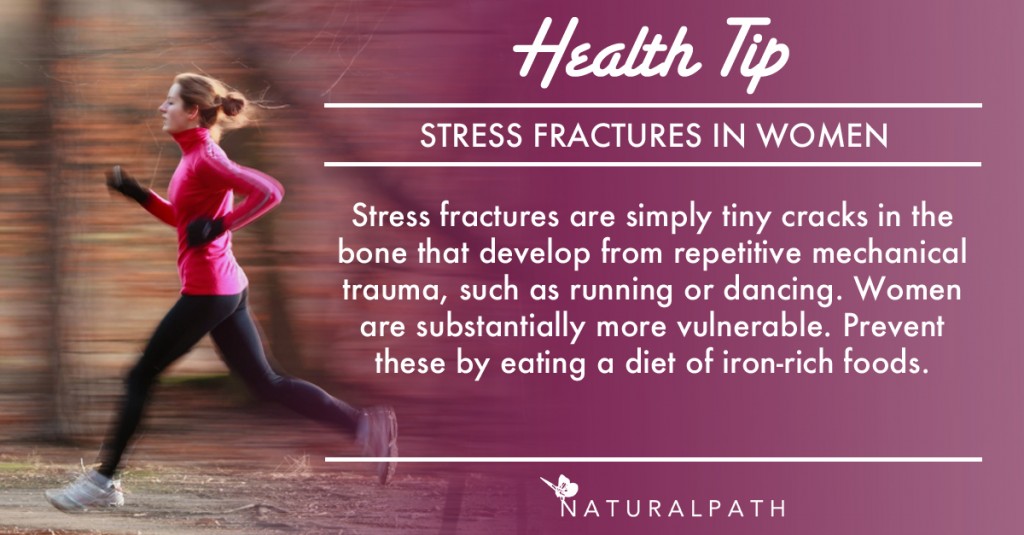Dr. Richard Maurer, ND
@drrichardmaurer
I just heard another story about a fine athlete going down for the count with stress fractures. I appreciate that my area has great orthopedic care and fine physical therapy. But what about prehab rather than rehab. Can we figure out who is at risk and not wait for the fractures to occur? Yes, and it simpler than you think.
Stress fractures are simply tiny cracks in the bone that develop from repetitive mechanical trauma, such as running or dancing. Women are substantially more vulnerable. In fact, a military study back in 2008 included 310 recruits—none of the 82 men had stress fractures whereas 27 women developed stress fractures in the same basic training. The study thoughtfully attempted to predict which women would develop stress fractures and the predictions were over 75% accurate. If women were low in iron, measured as ferritin, they were likely to develop fractures. Other factors? Tall and lean women were at higher risk and those who felt overly tired or “burned out”.1
The lead researcher as recently as 2015 found that men, despite having lower fracture risk than women, have significantly more stress fractures with low dietary vitamin D and calcium intake.1
Why women to such a greater degree than men? Hormones and blood loss are likely players. Hormonally, women do not have a high androgenic message—lower testosterone and DHEA compared to men—and the body does not lay down as much protein in response to physical stress. This reduces the speed and extent of bone and muscle recovery post exertion. Blood loss through menses raises the need for the nutrients that are lost, such as iron, B12, and folic acid—But iron, by far, is the most important. Iron rich foods have also, in the past 2 generations, fallen out of favor. Liver and red meats may be athletes’ best choice to manage and correct low iron. But liver is a hard sell to a young woman, so how do we figure out who needs the paté?
Simple, run a blood test—A test for vitamin D and ferritin at least. There are blood test panels that include a complete blood count (CBC), comprehensive metabolic panel, vitamin D and Ferritin. Many direct labs offer The Blood Code Discovery Panel which includes all the above and then some. Additionally, competitive athletes can add the hormones total testosterone and DHEA sulfate. These anabolic, androgenic hormones change over time but indicate the current hormonal capacity for muscle and bone recovery from strenuous exertion.
 In my metabolic clinic, I am too often faced with a young adult female athlete wearing an orthopedic boot and, after the fact, hoping to swiftly recover from stress fractures. Sure, I can run the right tests and correct the nutritional and hormonal culprits—But I’d like to see prevention, not treatment be the way of the future for athletes. If a few simple blood test results can steer an athlete toward top performances and away from injury, I am all in.
In my metabolic clinic, I am too often faced with a young adult female athlete wearing an orthopedic boot and, after the fact, hoping to swiftly recover from stress fractures. Sure, I can run the right tests and correct the nutritional and hormonal culprits—But I’d like to see prevention, not treatment be the way of the future for athletes. If a few simple blood test results can steer an athlete toward top performances and away from injury, I am all in.
 Dr. Richard Maurer is a licensed naturopathic physician who, after practicing in a primary care setting for twenty years, now provides a unique perspective on metabolic health and recovery. Dr. Maurer puts you in the driver’s seat of your health and wellness, helping you decode blood test results to find the diet and fitness habits that reverse and prevent metabolic conditions, such as pre and type 2 diabetes, weight gain and hypothyroid problems. His recent book, The Blood Code: Unlock the secrets of your metabolism [2014], provides the tools to understand and act on key blood tests and skin fold measurements to define your personalized diet, fitness and nutritional needs to recover health and vitality—disease reversal is only the beginning.
Dr. Richard Maurer is a licensed naturopathic physician who, after practicing in a primary care setting for twenty years, now provides a unique perspective on metabolic health and recovery. Dr. Maurer puts you in the driver’s seat of your health and wellness, helping you decode blood test results to find the diet and fitness habits that reverse and prevent metabolic conditions, such as pre and type 2 diabetes, weight gain and hypothyroid problems. His recent book, The Blood Code: Unlock the secrets of your metabolism [2014], provides the tools to understand and act on key blood tests and skin fold measurements to define your personalized diet, fitness and nutritional needs to recover health and vitality—disease reversal is only the beginning.
His personal and familial trend toward type 2 diabetes motivates him to empower people to recover their metabolic “sweet spot” through proven self-guided diet, nutritional, and fitness habits.
Dr. Maurer is the past president of the Maine Association of Naturopathic Doctors and regularly presents at health and medical conferences such as Weston Price Foundation, American Association of Naturopathic Physicians and the popular PaleoF(x). He lives in Maine with his wife Alexandra where they have raised three children.
Reference:
- Moran, D.S., et al., Dietary Intake and Stress Fractures among Elite Male Combat Recruits. JISSN. Journal of the International Society of Sports Nutrition, 2012. Web. 20 Nov. 2015.
